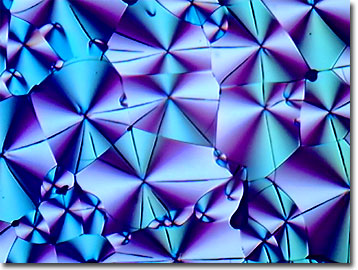Polarized Light Digital Image Gallery
Biotin (Vitamin H)
As a water-soluble member of the B-complex family of vitamins, biotin is required for growth and metabolism in humans. Often referred to as vitamin H, biotin is found naturally in liver, kidney, soy flour, egg yolk, cereal grains, and yeast.

View a second image of crystallized biotin.
View a third image of crystallized biotin.
View a fourth image of crystallized biotin.
In its physiologically active form, biotin is attached to the active site of four important carboxylase enzymes. The catalysis of fatty acid synthesis, gluconeogenesis, the metabolism of leucine (an essential amino acid), and the metabolism of cholesterol and odd-chain fatty acids depend on vitamin H. Important in the treatment of diabetes mellitus, biotin stimulates the secretion of insulin, increases the synthesis of glycogen (the storage form of glucose), and may increase the utilization of glucose to synthesize fats, thereby lowering blood glucose levels. It appears also that biotin plays a major role in DNA replication and transcription, as well as with the creation of antibodies and the metabolism of niacin (vitamin B-3). Interestingly, in the normal gut fauna of the human colon, the bacteria are capable of synthesizing their own biotin. However, it has not yet been determined how much biotin the host human can absorb from the commensal microorganisms.
Although biotin deficiencies are rare, prolonged intravenous feeding without biotin supplements or prolonged consumption of raw egg whites may result in hair loss, a scaly red rash, depression, and hallucinations. Avidin, an egg white protein, binds available biotin, preventing its absorption, unless the eggs are cooked and the protein is denatured. Biotin deficiencies can also be caused by two different inherited enzyme disorders, which can be countered by high-dose supplementations (40 to 100 milligrams biotin per day). Most recently, pregnant and nursing mothers have been advised to ensure proper addition of biotin (at least 30 micrograms daily) in their diets because the rapidly dividing cells of the developing fetus depletes biotin supplies, and deficiencies may cause birth complications and defects.
Contributing Authors
Omar Alvarado, Thomas J. Fellers and Michael W. Davidson - National High Magnetic Field Laboratory, 1800 East Paul Dirac Dr., The Florida State University, Tallahassee, Florida, 32310.
BACK TO THE POLARIZED LIGHT IMAGE GALLERY
BACK TO THE DIGITAL IMAGE GALLERIES
Questions or comments? Send us an email.
© 1995-2025 by Michael W. Davidson and The Florida State University. All Rights Reserved. No images, graphics, software, scripts, or applets may be reproduced or used in any manner without permission from the copyright holders. Use of this website means you agree to all of the Legal Terms and Conditions set forth by the owners.
This website is maintained by our
Graphics & Web Programming Team
in collaboration with Optical Microscopy at the
National High Magnetic Field Laboratory.
Last Modification Friday, Nov 13, 2015 at 01:19 PM
Access Count Since September 17, 2002: 8963
Visit the website of our partner in introductory microscopy education:
|
|
